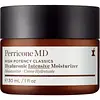What's inside
What's inside
 Key Ingredients
Key Ingredients

 Benefits
Benefits

 Concerns
Concerns

 Ingredients Side-by-side
Ingredients Side-by-side

Water
Skin ConditioningDimethicone
EmollientGlycerin
HumectantPentylene Glycol
Skin ConditioningNiacinamide
SmoothingButylene Glycol
HumectantCaprylic/Capric Triglyceride
MaskingAmmonium Acryloyldimethyltaurate/Vp Copolymer
Butyrospermum Parkii Butter
Skin ConditioningSqualane
EmollientSodium Hyaluronate Crosspolymer
HumectantBenzyl Alcohol
PerfumingUrea
BufferingTetrahexyldecyl Ascorbate
AntioxidantBisabolol
MaskingDimethyl Mea
BufferingStyrene/Acrylates Copolymer
Dimethicone/Vinyl Dimethicone Crosspolymer
Skin ConditioningCarbomer
Emulsion StabilisingSodium Polyacrylate
AbsorbentPhosphatidylcholine
EmulsifyingHydrogenated Lecithin
EmulsifyingCitric Acid
BufferingAllantoin
Skin ConditioningHyaluronic Acid
HumectantPolysilicone-11
Triacetin
AntimicrobialXanthan Gum
EmulsifyingTocopheryl Acetate
AntioxidantSodium Chloride
MaskingPhenoxyethanol
PreservativeRosmarinus Officinalis Leaf Extract
AntimicrobialMagnesium Aspartate
Skin ConditioningZinc Gluconate
Skin ConditioningSodium Lactate
BufferingLactic Acid
BufferingSerine
MaskingSorbitol
HumectantPotassium Sorbate
PreservativeSodium Benzoate
MaskingSodium Hyaluronate
HumectantDocosahexaenoic Acid
Skin ConditioningCopper Gluconate
Skin ConditioningWater, Dimethicone, Glycerin, Pentylene Glycol, Niacinamide, Butylene Glycol, Caprylic/Capric Triglyceride, Ammonium Acryloyldimethyltaurate/Vp Copolymer, Butyrospermum Parkii Butter, Squalane, Sodium Hyaluronate Crosspolymer, Benzyl Alcohol, Urea, Tetrahexyldecyl Ascorbate, Bisabolol, Dimethyl Mea, Styrene/Acrylates Copolymer, Dimethicone/Vinyl Dimethicone Crosspolymer, Carbomer, Sodium Polyacrylate, Phosphatidylcholine, Hydrogenated Lecithin, Citric Acid, Allantoin, Hyaluronic Acid, Polysilicone-11, Triacetin, Xanthan Gum, Tocopheryl Acetate, Sodium Chloride, Phenoxyethanol, Rosmarinus Officinalis Leaf Extract, Magnesium Aspartate, Zinc Gluconate, Sodium Lactate, Lactic Acid, Serine, Sorbitol, Potassium Sorbate, Sodium Benzoate, Sodium Hyaluronate, Docosahexaenoic Acid, Copper Gluconate
Water
Skin ConditioningGlycerin
HumectantCetearyl Alcohol
EmollientCaprylic/Capric Triglyceride
MaskingCetyl Alcohol
EmollientCeteareth-20
CleansingPetrolatum
EmollientPotassium Phosphate
BufferingCeramide NP
Skin ConditioningCeramide AP
Skin ConditioningCeramide EOP
Skin ConditioningCarbomer
Emulsion StabilisingDimethicone
EmollientBehentrimonium Methosulfate
Sodium Lauroyl Lactylate
EmulsifyingSodium Hyaluronate
HumectantCholesterol
EmollientPhenoxyethanol
PreservativeDisodium EDTA
Dipotassium Phosphate
BufferingTocopherol
AntioxidantPhytosphingosine
Skin ConditioningXanthan Gum
EmulsifyingEthylhexylglycerin
Skin ConditioningWater, Glycerin, Cetearyl Alcohol, Caprylic/Capric Triglyceride, Cetyl Alcohol, Ceteareth-20, Petrolatum, Potassium Phosphate, Ceramide NP, Ceramide AP, Ceramide EOP, Carbomer, Dimethicone, Behentrimonium Methosulfate, Sodium Lauroyl Lactylate, Sodium Hyaluronate, Cholesterol, Phenoxyethanol, Disodium EDTA, Dipotassium Phosphate, Tocopherol, Phytosphingosine, Xanthan Gum, Ethylhexylglycerin
 Reviews
Reviews

Ingredients Explained
These ingredients are found in both products.
Ingredients higher up in an ingredient list are typically present in a larger amount.
This ingredient is an emollient, solvent, and texture enhancer. It is considered a skin-softener by helping the skin prevent moisture loss.
It helps thicken a product's formula and makes it easier to spread by dissolving clumping compounds.
Caprylic Triglyceride is made by combining glycerin with coconut oil, forming a clear liquid.
While there is an assumption Caprylic Triglyceride can clog pores due to it being derived from coconut oil, there is no research supporting this.
Learn more about Caprylic/Capric TriglycerideCarbomer is a polymer of acrylic acid. Its main role is to create a gel consistency.
A high amount of carbomer can cause pilling or balling up of products. Don't worry, most products contain 1% or less of carbomer.
Dimethicone is a type of synthetic silicone created from natural materials such as quartz.
What it does:
Dimethicone comes in different viscosities:
Depending on the viscosity, dimethicone has different properties.
Ingredients lists don't always show which type is used, so we recommend reaching out to the brand if you have questions about the viscosity.
This ingredient is unlikely to cause irritation because it does not get absorbed into skin. However, people with silicone allergies should be careful about using this ingredient.
Note: Dimethicone may contribute to pilling. This is because it is not oil or water soluble, so pilling may occur when layered with products. When mixed with heavy oils in a formula, the outcome is also quite greasy.
Learn more about DimethiconeGlycerin is already naturally found in your skin. It helps moisturize and protect your skin.
A study from 2016 found glycerin to be more effective as a humectant than AHAs and hyaluronic acid.
As a humectant, it helps the skin stay hydrated by pulling moisture to your skin. The low molecular weight of glycerin allows it to pull moisture into the deeper layers of your skin.
Hydrated skin improves your skin barrier; Your skin barrier helps protect against irritants and bacteria.
Glycerin has also been found to have antimicrobial and antiviral properties. Due to these properties, glycerin is often used in wound and burn treatments.
In cosmetics, glycerin is usually derived from plants such as soybean or palm. However, it can also be sourced from animals, such as tallow or animal fat.
This ingredient is organic, colorless, odorless, and non-toxic.
Glycerin is the name for this ingredient in American English. British English uses Glycerol/Glycerine.
Learn more about GlycerinPhenoxyethanol is a preservative that has germicide, antimicrobial, and aromatic properties. Studies show that phenoxyethanol can prevent microbial growth. By itself, it has a scent that is similar to that of a rose.
It's often used in formulations along with Caprylyl Glycol to preserve the shelf life of products.
Sodium Hyaluronate is hyaluronic acid's salt form. It is commonly derived from the sodium salt of hyaluronic acid.
Like hyaluronic acid, it is great at holding water and acts as a humectant. This makes it a great skin hydrating ingredient.
Sodium Hyaluronate is naturally occurring in our bodies and is mostly found in eye fluid and joints.
These are some other common types of Hyaluronic Acid:
Learn more about Sodium HyaluronateWater. It's the most common cosmetic ingredient of all. You'll usually see it at the top of ingredient lists, meaning that it makes up the largest part of the product.
So why is it so popular? Water most often acts as a solvent - this means that it helps dissolve other ingredients into the formulation.
You'll also recognize water as that liquid we all need to stay alive. If you see this, drink a glass of water. Stay hydrated!
Learn more about WaterXanthan gum is used as a stabilizer and thickener within cosmetic products. It helps give products a sticky, thick feeling - preventing them from being too runny.
On the technical side of things, xanthan gum is a polysaccharide - a combination consisting of multiple sugar molecules bonded together.
Xanthan gum is a pretty common and great ingredient. It is a natural, non-toxic, non-irritating ingredient that is also commonly used in food products.
Learn more about Xanthan Gum